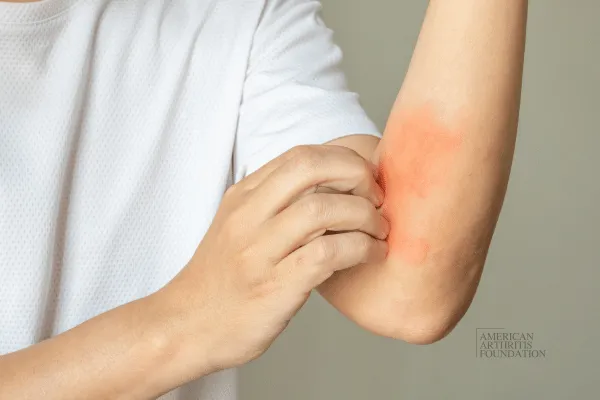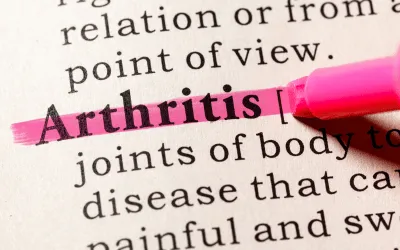About Arthritis
As the nation’s #1 cause of disability, arthritis affects nearly 60 million adults and 300,000 children. Over 100 types of arthritis and related conditions damage the joints and often other organs.
How can we assist you?
Helpful Tools for You

The Surprising Connection Between Psoriasis and Joint Pain: What You Need to Know
When you think of psoriasis, you probably picture those red, flaky skin patches that can cause discomfort and self-consciousness. But what if we told you that psoriasis doesn’t just affect your skin—it can impact your joints too? In fact, up to 25% of people with psoriasis experience joint pain, and for some, that pain turns into a more serious condition known as psoriatic arthritis (PsA).
It’s a connection that surprises many, but researchers are actively studying it. And the results could transform how we approach psoriasis and arthritis, helping people live healthier, pain-free lives.
So, What Is Psoriatic Arthritis?
While psoriasis primarily affects the skin, psoriatic arthritis (PsA) is a type of inflammatory arthritis that impacts the joints. It can cause swelling, stiffness, and pain, which can be just as uncomfortable as the skin symptoms of psoriasis, if not more. What’s more, PsA can develop silently in some people, without obvious skin symptoms beforehand.
Here’s where things get interesting: about one-third of people with psoriasis may eventually develop PsA. This means that many people who currently deal with psoriasis are at risk of future joint pain—but experts are working hard to figure out why this happens and how to stop it before it starts.
A Global Effort: The HIPPOCRATES Project
In an exciting effort to better understand the link between psoriasis and joint pain, researchers from Oxford University, University College Dublin, and other leading institutions are conducting a massive international study called the HIPPOCRATES Project. The goal? To uncover early warning signs of PsA and find ways to prevent it from developing in people with psoriasis.
So far, the project has been tracking nearly 3,000 psoriasis patients, with 25% of them already experiencing joint symptoms. But this is just the beginning. Over the course of three years, the study will follow these patients, gathering insights into when and why PsA appears—and how it can be stopped.
How Are They Doing It?
What makes the HIPPOCRATES Project so groundbreaking is the scope and the approach. Researchers are collecting detailed health information from participants through online questionnaires and even using finger-prick blood samples that people can send in by mail. This allows patients to participate from home, no matter where they live, and ensures that researchers gather a large, diverse pool of data.
The project plans to recruit 25,000 people with psoriasis across 12 European countries, giving scientists an unprecedented amount of data to analyze. This data could lead to the discovery of key risk factors that predict who will develop PsA, opening the door to early interventions.
Can PsA Be Prevented?
The ultimate goal of this study is to find out if we can prevent psoriatic arthritis from developing in the first place. And while there’s no magic pill just yet, researchers are exploring a variety of lifestyle interventions that could help. These include things like:
Regular exercise to keep joints healthy
Stress management techniques to reduce inflammation
Dietary adjustments to support overall well-being
The idea is that by identifying high-risk individuals early, we can recommend simple changes that might keep arthritis at bay and improve quality of life.
Why This Study Matters
Psoriatic arthritis can be life-altering. It doesn’t just cause joint pain—it can also affect mobility and lead to long-term joint damage if left untreated. That’s why the HIPPOCRATES Project is such an important step forward in our understanding of psoriasis and arthritis.
By focusing on early detection and prevention, this research could dramatically change how we treat people with psoriasis, giving them tools to manage their skin and joint health long before PsA develops. Plus, with so many patients involved from different countries, the findings are likely to have a wide-reaching impact.
What’s Next?
As the HIPPOCRATES Project continues to unfold, we’re hopeful that its discoveries will lead to better treatments and even preventative measures for PsA. And at the American Arthritis Foundation, we’ll be watching closely to bring you the latest updates on this groundbreaking research.
If you or someone you know is living with psoriasis, staying informed about this connection between skin and joint health is key. Whether through lifestyle changes or new treatments on the horizon, there are steps you can take to protect your joints and improve your overall well-being.
Stay tuned for more on the link between psoriasis and joint health—and follow us for the latest in arthritis research, treatment options, and wellness tips!
Join the Conversation
Do you have psoriasis or PsA? We’d love to hear your story! Share your experiences with us in the comments below and let’s keep the conversation going about how we can make life with psoriasis and joint pain easier for everyone.
Effects of Arthritis

Cause of Disability
In the United States, 23% of all adults, or more than 54 million people, have arthritis. It is a leading cause of work disability, with annual costs for medical care and lost earnings of $303.5 billion.

Workforce Effects
Sixty percent of US adults with arthritis are of working age (18 to 64 years). Arthritis can limit the type of work they are able to do or keep them from working at all.

Global Impact
In fact, 8 million working-age adults report that their ability to work is limited because of their arthritis. For example, they may have a hard time climbing stairs or walking from a parking deck to their workplace.
Promoting Interventions That Reduce Arthritis Pain
American Arthritis Foundation recognizes several proven approaches to reduce arthritis symptoms:
Be active. Physical activity—such as walking, bicycling, and swimming—decreases arthritis pain and improves function, mood, and quality of life. Adults with arthritis should move more and sit less throughout the day. Getting at least 150 minutes of moderate-intensity physical activity each week is recommended.
Protect your joints. People can help prevent osteoarthritis by avoiding activities that are more likely to cause joint injuries.
Talk with a doctor. Recommendations from health care providers can motivate people to be physically active and join a self-management education program. Should your arthritis be interfering with your activities of daily living you may be a candidate to receive many new treatments, and learn how to reverse the arthritis condition.
Have a question?
We're Here to Help
By providing my phone number, I agree to receive text messages from the business.

